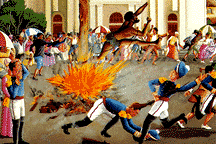This conception of Latin American life in the slow lane applies to all temporal and social scales: from a corner store's relaxed approach to opening times to the delays of an over-bureaucratized state, from the individual slumbering under his sombrero to the patience of whole indigenous races, from the slow swing of a hammock to lands that the twentieth-century has passed by, all facets of the region's culture and history are imagined to be bathed in this thick viscosity.
Uruguayan José Enrique Rodó celebrated a Latin habit of leisure that allowed for philosophy and contrasted with North American utilitarian industriousness. Perhaps most influentially, Gabriel García Márquez's fictional Macondo is affectionately portrayed as a quaint tropical oasis inhabiting its own, parallel, unchanging temporality.
So Fernando Ortiz's emphasis is perhaps brusque and surprising. His stress is on immense speed and tumultuous changes, a breathtaking rush of precipitate adaptation and re-invention:
The whole gamut of culture run by Europe in a span of more than four millenniums took place in Cuba in less than four centuries. In Europe the change was step by step; here it was by leaps and bounds. (Cuban Counterpoint 99)He notes particularly the abruptness of the transition ushered in by Spanish colonization:
At one bound the bridge between the drowsing stone ages and the wide-awake Renaissance was spanned. In a single day various of the intervening ages were crossed in Cuba. [. . .] If the Indies of America were a New World for the Europeans, Europe was a far newer world for the people of America. They were two worlds that discovered each other and collided head-on. (99-100)Far from a vision of Latin American culture as close to nature, bound to the slow rhythms of either the seasons or the sea gently lapping on the beach, Ortiz suggests a history of continual dislocation, deracination, uprooting, confrontation, confusion, and innovation that comprise a process he designates with the term "transculturation."
In short, for Ortiz, Cuba, Spain's richest colony and source of so much of Europe's wealth, has long been a cauldron of activity stirred up to an accelerated pace. It was always revolutionary, always the site of struggle and creative disruption, long before the 1959 uprising that brought Castro to power.
But no doubt the same could be said for Latin America as a whole: rather than a region left out of the loop of world history, it was here that modernity itself was born and continues to thrive.
 And no wonder that Alejo Carpentier, another Cuban though writing in a somewhat different context, could say that "the presence and vitality of this marvelous real" was "the heritage of all America" ("On the Marvelous Real in America" 87).
And no wonder that Alejo Carpentier, another Cuban though writing in a somewhat different context, could say that "the presence and vitality of this marvelous real" was "the heritage of all America" ("On the Marvelous Real in America" 87). In Carpentier's founding manifesto for what would later be packaged (and slowed down) as "magical realism," what is most striking is again the sense of dynamism and potential that he identifies with what he terms an "unexpected richness of reality or an amplification of the scale and categories of reality, perceived with particular intensity by virtue of an exaltation of the spirit that leads it to a kind of extreme state" (86).
But rather than merely an "extreme state," Carpentier's original Spanish refers here to an estado límite or "limit state." So why not envisage Latin America not as perpetual laggard but as a region always at the limit, at the cutting edge (too often, literally the bleeding edge) of modernization and history?
No comments:
Post a Comment